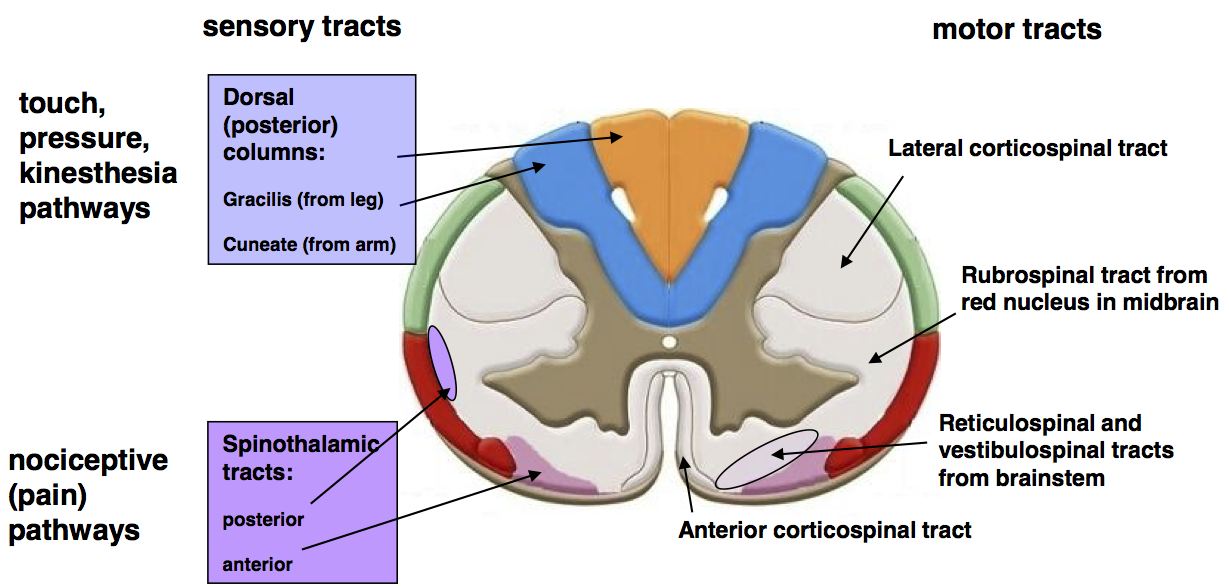Makindo Medical Notes"One small step for man, one large step for Makindo" |
|
|---|---|
| Download all this content in the Apps now Android App and Apple iPhone/Pad App | |
| MEDICAL DISCLAIMER: The contents are under continuing development and improvements and despite all efforts may contain errors of omission or fact. This is not to be used for the assessment, diagnosis, or management of patients. It should not be regarded as medical advice by healthcare workers or laypeople. It is for educational purposes only. Please adhere to your local protocols. Use the BNF for drug information. If you are unwell please seek urgent healthcare advice. If you do not accept this then please do not use the website. Makindo Ltd. |
Anterior Spinal Cord syndrome
-
| About | Anaesthetics and Critical Care | Anatomy | Biochemistry | Cardiology | Clinical Cases | CompSci | Crib | Dermatology | Differentials | Drugs | ENT | Electrocardiogram | Embryology | Emergency Medicine | Endocrinology | Ethics | Foundation Doctors | Gastroenterology | General Information | General Practice | Genetics | Geriatric Medicine | Guidelines | Haematology | Hepatology | Immunology | Infectious Diseases | Infographic | Investigations | Lists | Microbiology | Miscellaneous | Nephrology | Neuroanatomy | Neurology | Nutrition | OSCE | Obstetrics Gynaecology | Oncology | Ophthalmology | Oral Medicine and Dentistry | Paediatrics | Palliative | Pathology | Pharmacology | Physiology | Procedures | Psychiatry | Radiology | Respiratory | Resuscitation | Rheumatology | Statistics and Research | Stroke | Surgery | Toxicology | Trauma and Orthopaedics | Twitter | Urology
Related Subjects: | Transverse myelitis | Acute Disseminated Encephalomyelitis |Cervical spondylosis |Spinal Cord Anatomy |Acute Disc Prolapse |Spinal Cord Compression |Spinal Cord Haematoma |Foix-Alajouanine syndrome |Cauda Equina |Conus Medullaris syndrome |Anterior Spinal Cord syndrome |Central Spinal Cord syndrome |Brown-Sequard Spinal Cord syndrome
🧠 Anterior Spinal Cord Syndrome (ASCS) is an incomplete spinal cord injury involving the anterior two-thirds of the cord. It leads to motor paralysis and loss of pain/temperature sensation below the lesion, with sparing of vibration and proprioception (posterior columns). The commonest cause is anterior spinal artery infarction, but trauma and compression are also important. Prognosis is often poor compared to other incomplete cord syndromes.
📌 Introduction
- Spinal cord infarction is rare but catastrophic.
- 🩸 The anterior spinal artery supplies ~2/3 of the cord (motor + spinothalamic tracts) and is most vulnerable in the mid-thoracic "watershed" region (T4–T8).
- Injury here can arise from vascular, traumatic, or compressive causes.
⚠️ Causes
- Ischaemia: Aortic surgery, dissection, severe hypotension → anterior spinal artery occlusion.
- Trauma: Cervical/thoracic fracture–dislocation injuring anterior cord.
- Disc Herniation: Large central disc compressing anterior cord.
- Spinal Tumours: Neoplasms compressing blood supply.
- Infections: Spinal epidural abscess, transverse myelitis.
- Vascular Malformations: AVMs, aneurysms compromising flow.
🩻 Anatomy

- Anterior spinal artery = single midline vessel running length of cord, reinforced by segmental arteries (e.g. artery of Adamkiewicz at T9–T12).
- Supplies corticospinal & spinothalamic tracts; posterior columns are spared (separate supply from posterior spinal arteries).
🧾 Clinical Features
- 💪 Motor: Paraplegia or quadriplegia (depending on level).
- 🔥 Pain/Temperature: Lost below lesion (spinothalamic tract).
- 🎯 Proprioception/Vibration: Preserved (dorsal columns spared).
- Bladder & bowel dysfunction common due to autonomic involvement.
- May present acutely (sudden vascular occlusion) or subacutely (compression/tumour).
🧠 Key Exam Pearl: “Anterior = motor & pain/temp loss, posterior = proprioception spared.”
🔍 Investigations
- MRI (gold standard): Identifies cord ischaemia, compression, tumours, or disc herniation.
- CT: Best for bony trauma, fractures, or dislocations.
- Spinal Angiography: Defines vascular occlusion/AVMs if intervention is planned.
🩺 Management
- 🔴 Acute: ABC resuscitation, spinal immobilisation (if trauma), maintain perfusion.
- 💊 Steroids: High-dose methylprednisolone is controversial; consider case-by-case.
- 🩸 Vascular: Endovascular repair, bypass, or stenting if vascular occlusion.
- 🔧 Surgical decompression: For cord compression (disc, tumour, haematoma).
- 🧑⚕️ Rehabilitation: Physiotherapy, occupational therapy, bowel/bladder management, DVT prophylaxis, and pressure sore prevention.
📊 Prognosis
- Recovery of motor function is usually poor, especially if initial paralysis is complete.
- Sensory sparing of proprioception often persists, aiding rehabilitation.
- Early diagnosis, decompression (if compressive), and optimisation of perfusion are key to improving outcomes.